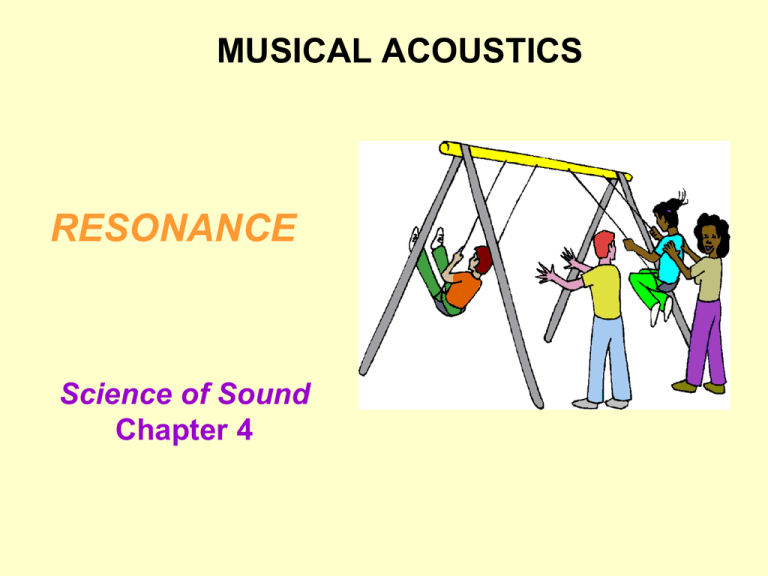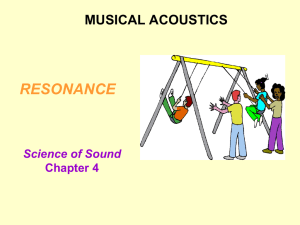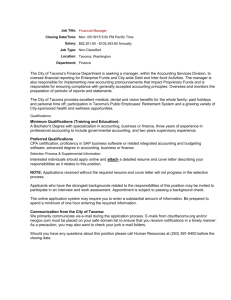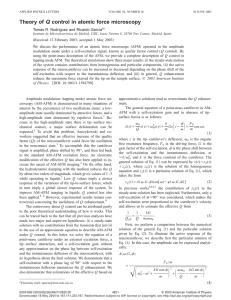RESONANCE CHAPTER 4
advertisement

MUSICAL ACOUSTICS RESONANCE Science of Sound Chapter 4 Resonance Resonance occurs when a vibrating system is driven at its natural frequency. The amplitude of the vibrator reaches a maximum, limited only by the damping. PHASE DIFFERENCE BETWEEN CRANK AND MASS The Pasco Driven Harmonic Motion Analyzer For extra credit: Driven harmonic analyzer (“Texas tower”) Make graphs of amplitude vs frequency and phase angle vs frequency for 2 amounts of damping STANDING WAVES ON A STRING Partials, harmonics, and overtones Partials are components of a complex tone or vibration The fundamental is the partial on which a complex vibration or tone is built Harmonics are partials whose frequencies are multiples of a fundamental frequency Overtones are partials above the fundamental frequency OPEN AND CLOSED PIPES OPEN PIPE CLOSED PIPE STANDING WAVES IN CYLINDRICAL AND CONICAL PIPES ACOUSTIC IMPEDANCE Acoustic impedance is the ratio of sound pressure p to volume velocity U ZA = p/U APPARATUS FOR GRAPHING THE ACOUSTIC IMPEDANCE OF WIND INSTRUMENTS HELMHOLTZ RESONATOR HELMHOLTZ RESONATOR TUNING FORK D.A. Russell, "On the sound field radiated by a tuning fork," Am. J. Phys., 68(12), 1139-45 (2000). CHOIRCHIMES CHOIRCHIME VIBRATIONS SINGING RODS AND WINEGLASSES SINGING RODS In a bar or rod with free ends the fundamental mode will have a node at its center, and the maximum vibration occurs at the ends (just as in a pipe open at both ends). The next mode has two modes at ¼ L and ¾ L Stroking an aluminum rod with the fingers to excite these longitudinal resonances can create rather loud sounds SELF-EXCITATION A linear force or motion can excite vibratory motion by a process called self-excitation. Examples of this are the stick-slip motion that excites a wineglass or a violin string SELF-EXCITATION A linear force or motion can excite vibratory motion by a process called self-excitation. Examples of this are the stick-slip motion that excites a wineglass or a violin string COLLAPSE OF THE TACOMA NARROWS BRIDGE A DRAMATIC CASE OF SELF-EXCITED OSCILLATION The Collapse of the Tacoma Narrows Bridge A spectacular example of self excitation Positive feedback (or negative damping) made it possible for a nearly steady flow of air to excite torsional oscillations Vortex shedding played a role, but the feedback mechanism appears to have been more subtle than depicted in the Caltech video Physically it is a little like the self-excitation of a violin string by the steady motion of a bow. The Collapse of the Tacoma Narrows Bridge Futher reading for extra credit: Read the following papers, and write a paper on the physics of the Tacoma Narrows Bridge collapse: K.Y. Billah and R.H.Scanlon, “Resonance, Tacoma Narrows bridge failure, and undergraduate physics textbooks,” American Journal of Physics 59, 118-124 (1991). D. Green and W.G.Unruh, “The failure of the Tacoma Bridge: A physical model,” American Journal of Physics 74, 706-716 (2006) SYMPATHETIC VIBRATION The vibrating string of a piano or guitar excites the soundboard to vibrate (and thus to produce much more sound). This is called sympathetic vibration. Sympathetic vibration and self-excitation of vibration should not be confused with resonance. Assignment for January 20 Read Chapter 5 Exercises 1-8 (p.73) For extra credit: Driven harmonic analyzer (“Texas tower”) Make graphs of amplitude vs frequency and phase angle vs frequency for 2 amounts of damping Show the modes of a wineglass that can be excited by rubbing with a finger; bowing radially with a violin bow; driving it with a loudspeaker. Ref: J. Acoust. Soc. Am. 95, 1108-1111 (1994). Paper on the physics of the Tacoma Bridge collapse.





